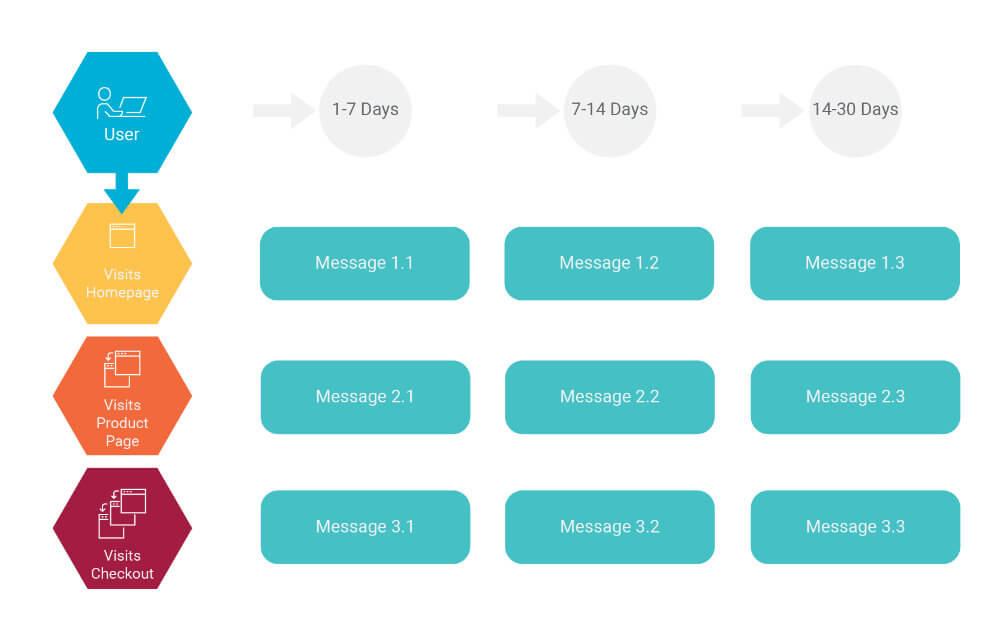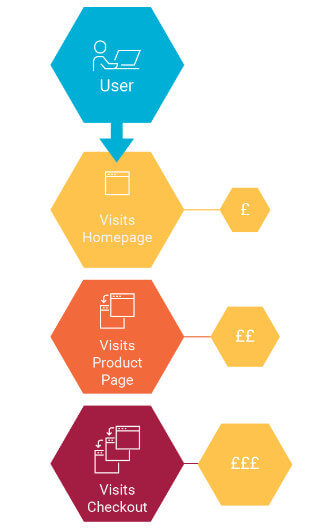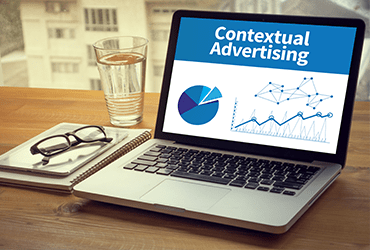
![]() Insights
Insights
Paid social advertising is a great way to get your brand in front of the right audience and generate sales online. As with all paid advertising, it’s important that the money you spend is used efficiently to ensure a healthy ROI.
One way to improve the conversion rates of your paid social campaigns is by using sequential messaging. It’s a remarketing technique which tells a story through a series of adverts; the ads shown to a user changes depending on what adverts they have already seen, how far down the funnel they have travelled, and the length of time that has passed since they have engaged with your website.
Sequential messaging works in two ways:
The more times your audience is exposed to an advert, the less effective it gets. Why? The recipient becomes bored with the advert or messaging and stops paying attention to it. Sequential messaging ensures that the same user sees different ads and messages, with each new advert reinforcing previous messages while building on the story.
Different searchers want different things. Someone at the beginning of the customer buying journey is more likely to be looking for informational content, like guides and reviews, than they are specific products. Targeting these prospects with ads aimed at making sales (for example, ads containing discount codes or urgency messages like ‘last chance to buy’) are unlikely to convert, because they are still in the research phase and are therefore less likely to click.
Similarly, targeting someone who has carried out all their research and is ready to buy with an advert which isn’t actionable and pushing them to convert, may cause you to miss out on conversions.
By targeting users with different ads depending on where they are in the customer buying journey, we can ensure that the messages are relevant, and help to push them along to the next step and keep your click-through rate (CTR) and relevancy score high.
When setting up sequential messaging campaigns, we need to identify which actions should trigger a different type of advert.
Common triggers we set up for are:

The ads shown vary depending on their last action. Someone who clicked through to the homepage and then left might be shown ads which highlight key brand messaging and USPs, while a checkout abandoner would see ads displaying safety or urgency messages, such as free returns on all orders, or low stock levels. By serving ads in a set sequence, we can move consumers down the funnel from awareness to intent, and ultimately to conversion.
If a user has not progressed along the journey, we also change the advert they see to highlight different selling points as time passes. This prevents ad fatigue, while keeping the messaging consistent and strong. Different USPs resonate with different users too; by rotating through the different messages you are more likely to find the one that resonates with each user.
Unique selling points in sequential messaging campaigns are a good way of ensuring your brand stands out from its competitors at any given point in the customer buying journey.
Using emotional messaging can be used in addition to your USPs, to further increase the likelihood that someone will choose to buy from your brand. Studies have consistently found that the someone’s emotional response to an ad has more influence on their intent to buy than the ad content, with some cases showing emotional campaigns to work twice as well as rational ad campaigns.
Emotional messaging works by tapping into a subconscious emotion, which makes a product or brand stand out. Emotions help consumers to differentiate brand A from a near identical brand or B, C, D etc.

Sequential messaging is an effective way of remarketing someone through the customer buying journey, resulting in a purchase. However, it doesn’t end there.
Once a checkout has been completed, we can use sequential messaging to nurture customer loyalty and encourage repeat purchases. By correctly segmenting your CRM and integrating it into platforms such as Facebook, you can target them at the right time for repurchase, entering them back into your sequential messaging funnel when they visit the website again.
It’s not just the advert shown that changes in sequential messaging; the maximum bid we put in also changes. The further along the customer buyer journey someone is, the more we’re willing to bid, as we’re more likely to see a sale.
The more time that passes after an action, the less we are also willing to bid. This is because as more time passes, it’s less likely that these users will make a purchase.

Get in touch with our team and find out how our experts can take your programmatic campaigns to the next level.

![]() Insights
Insights

![]() Insights
Insights

![]() Insights
Insights